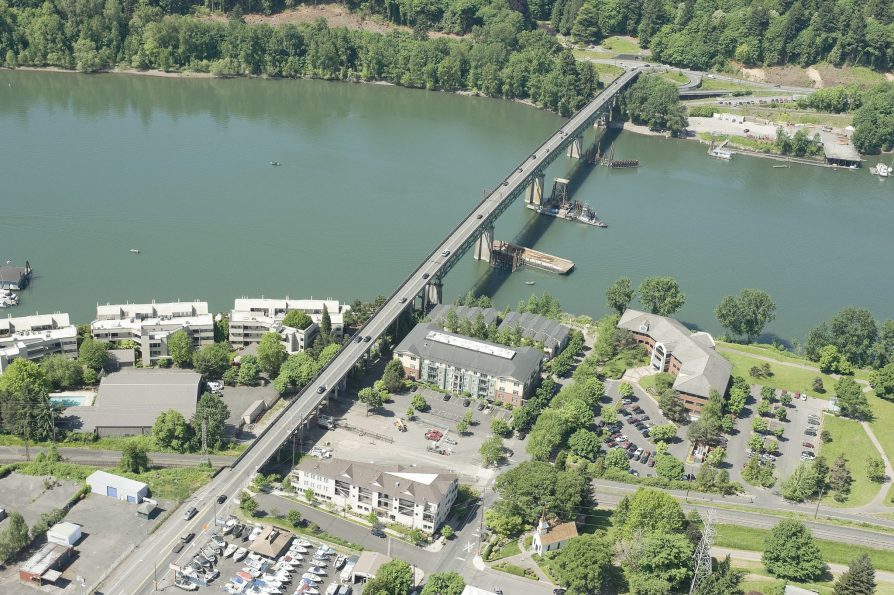)
Omega Morgan To Move Portland’s Sellwood Bridge
The Sellwood Bridge, at 1,972 ft.long, 75 ft. high and, 28 ft. wide, is among the state’s busiest bridges with 30,000 vehicle crossings each day. On Jan. 19, 2013 a Pacific Northwest-based Omega Morgan crew will slide the entire structure, in one piece and on a radius into a new position over the Willamette River. It will then become a temporary route beginning Jan. 24 while a new $307.5 million bridge is built in the original location.
“We are really pleased to be involved in this high important, complex and exciting project,” said John McCalla, Omega Morgan’s CEO and president.
The project has been called one of the longest bridge moves ever. It is complicated by the fact that this will not be a straight-across move. Instead, the east end of the bridge needs to be moved only 33 ft. while the west end must be moved 66 ft. The new bridge will open in 2016.
Both Omega Morgan and Slayden/Sundt Joint Venture have successfully used this detour bridge method on other projects. “Omega Morgan has moved bridges weighing upwards of eight million pounds, but this one does offer some additional challenges,” McCalla said.
Omega Morgan’s chief engineer, Ralph DiCaprio said the company welcomes the challenge. “This is why we like what we do. There’s something different on every project.”
Devising a strategy to move the bridge in one piece helped Omega Morgan win the contract after showing that it will save time, money and duplication of efforts, according to parties involved in the project.
DiCaprio created a plan to slide the aging Sellwood Bridge on skid gear to the north of the existing bridge and then mount it on new piers that have been built in the river. This will then become the “shoofly” or detour while construction begins on the new bridge. For those who are unsure about the old bridge’s stability, they can rest easy that it will be secure before traffic resumes, officials on the project said.
The Multnomah County Board of Commissioners approved this method June 16, 2012 after learning about several advantages proposed by Omega Morgan. According to Larry Gescher, construction manager for general contractor Slayden/Sundt Joint Venture, several advantages are provided by the shoofly process, including:
- It will save in the range of $5 to $10 million over other methods proposed.
- The new bridge can be built entirely in one phase.
- It saves up to a year in construction time.
- The temporary detour structure will be as strong as, if not stronger, than the existing Sellwood Bridge (including seismically.)
- There is no need for redundant structural features on the new bridge and this method allows for a sleeker design.
- Because drivers will be going over the temporary bridge, they will be separated from construction workers, ensuring a safer work environment.
- There will be fewer temporary work bridges and less in-water impact.
Temporary approach spans have been installed at the west and east ends of the relocated bridge to link Highway 43 in southwest Portland to S.E. Tacoma St. These will remain in place throughout construction of the new bridge.
The Old Sellwood Bridge
The 87-year-old bridge replaced a ferry called the John F. Caples. The steam-powered ferry took an average of 582 vehicles and 482 pedestrians across the Willamette River every day, compared to the 30,000 vehicles crossing each day in 2012.
The Sellwood was Portland’s first fixed-span bridge, which means it was the first in Portland that did not have a draw or swing span. In 1960, the Sellwood Bridge underwent extensive repair to prevent it from collapsing after settling issues caused cracked concrete.
Among the bridge deficiencies that hastened the decision to replace the current bridge are:
- Cannot handle the current volume of traffic.
- Has a rating of two out of 100 on the efficiency scale.
- Buses and heavy trucks are restricted from using the bridge.
- It has narrow lanes and sidewalk and no shoulders.
- Also has no bike facilities and poor connections to a trail system.
- The bridge is not designed to withstand earthquakes even though the area is in one of the most dangerous earthquake zones in the U.S.
The new bridge is projected to cost $307.5 million, being built in part with $17.7 million from the federal government, including from a Transportation Investment Generating Economic Recovery program (TIGER Grant.)
The new bridge was approved by Multnomah County, Portland City Council, Metro’s Joint Policy Advisory Committee on Transportation and Metro Council.











